
Tetratheca is a genus of around 50 to 60 species of shrubs endemic to Australia. It is classified in the botanical family Elaeocarpaceae, now known to encompass the family Tremandraceae, which the genus originally belonged to. It occurs throughout extratropical Australia, and has been recorded in every mainland state except the Northern Territory.

Grevillea pinaster is a shrub in the family Proteaceae. It is endemic to south-western Western Australia.

Grevillea celata, the Nowa Nowa grevillea or Colquhoun grevillea, is a shrub which is endemic to Victoria, Australia. It is closely related to Grevillea alpina and Grevillea chrysophaea.
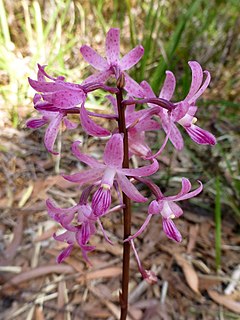
Dipodium roseum, commonly known as rosy hyacinth-orchid or pink hyacinth-orchid, is a leafless saprophytic orchid found in east and south-eastern Australia. In summer it produces a tall flowering stem with up to fifty pale pink flowers with small, dark red spots. A widespread and common species it is often confused with D. punctatum but has darker, less heavily spotted flowers.
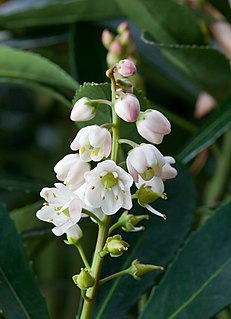
Anopterus glandulosus, commonly known as native laurel or Tasmanian laurel, is a species of shrub or small tree in the family Escalloniaceae. Endemic to south and southwestern Tasmania, A. glandulosus is widespread in the moist understoreys of Tasmanian temperate rainforests and wet sclerophyll forests from sea level to mountainous regions below 1,200 metres (3,937 ft) above sea level.

Olearia phlogopappa commonly known as the dusty daisy-bush or alpine daisy-bush is a species of flowering plant in the family Asteraceae that is commonly found in eastern New South Wales, Victoria and Tasmania. It is a small shrub with greyish-green foliage, daisy-like flowers in white, pink or mauve that can be seen from spring to late summer.
Correa glabra var. turnbullii, the narrow-bell correa, is a variety of Correa glabra, a shrub native to Australia. It grows to 1 to 2 metre high and wide, with branchlets sparsely covered with rust-brown hairs. Its leaves are up to 4.5 cm long and 1.2 cm wide and are dark green on the upper surface, while the lower surface is covered with hairs and pale grey. The pendent, tubular flowers are pink or red with green tips, appearing between April and August in their native range.
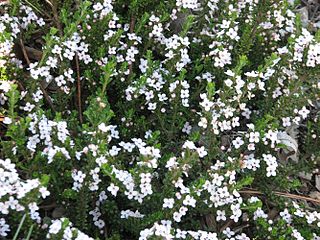
Zieria citriodora, commonly known as lemon-scented zieria, is a species of flowering plant in the citrus family Rutaceae and is endemic to a small area near the border between New South Wales and Victoria. It is a small shrub with lemon-scented leaves and small, pale pink or white flowers which appear from late winter to summer.

Zieria laevigata commonly known as smooth zieria, smooth-leaved zieria or twiggy midge bush is a species of flowering plant in the citrus family Rutaceae and is endemic to eastern Australia. It is an erect shrub with smooth, three-part leaves and pale pink or white flowers with four petals and four stamens. It grows in poor soil on rocky outcrops and flowers from late winter to spring.
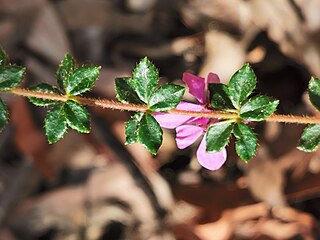
Tetratheca thymifolia, commonly known as black-eyed Susan or thyme pink-bells, is a small shrub in the family Elaeocarpaceae found in southeastern Australia.
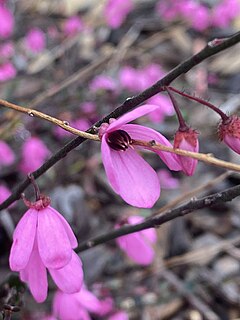
Tetratheca ciliata, commonly known as pink bells, is a small shrub in the family Elaeocarpaceae. It is endemic to southern Australia.
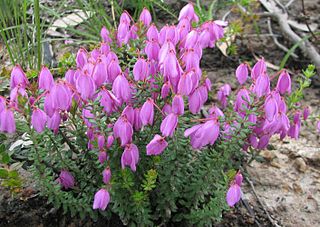
Tetratheca bauerifolia, commonly known as heath pink-bells, is a small shrub in the family Elaeocarpaceae. It is endemic to eastern Australia.It is a small shrub which may grow to 30 cm high. Deep pink flowers appear between September and December in the species' native range. The species was first formally described by Victorian Government Botanist Ferdinand von Mueller in 1853 in Synopsis Tremandrearum. It occurs in Victoria and New South Wales.

Leptospermum turbinatum, commonly known as shiny tea-tree, is a species of spreading shrub that is endemic to the Grampians and nearby ranges in Victoria, Australia. It has thin, rough bark, elliptical to lance-shaped leaves with the narrower end towards the base, relatively large white flowers and fruit that remains on the plant at maturity.

Persoonia arborea, commonly known as tree geebung, is a species of large shrub or small tree that is endemic to Victoria, Australia.
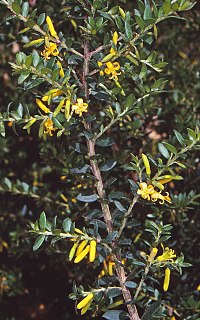
Persoonia asperula, commonly known as mountain geebung, is a plant in the family Proteaceae and is endemic to south-eastern Australia. It is an erect or prostrate shrub with smooth bark, mostly elliptic to oblong leaves and yellow flowers borne singly or in groups of up to nine. It mostly occurs in the Southern Highlands of New South Wales. A small population in Victoria may be a different species.

Coleonema pulchellum, commonly known as confetti bush, buchu, diosma or breath of heaven, is a shrub which is endemic to South Africa.

Eremophila glandulifera is a flowering plant in the figwort family, Scrophulariaceae and is endemic to Western Australia. It is a small shrub with hairy, grey foliage and attractive deep pink to red flowers usually growing in mulga woodland.
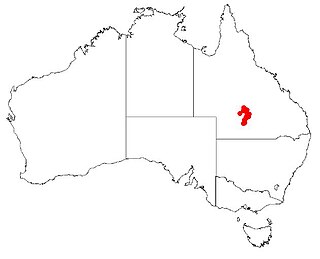
Hakea maconochieana is a shrub in the family Proteacea and is endemic to Queensland Australia. It is a rare species with red flowers, needle-like leaves and an upright or spreading shrub.

Hakea grammatophylla is a shrub of the family Proteacea that is endemic to the Northern Territory, Australia. It is a variable, sparsely branched shrub with pink to reddish flowers from March to late winter.

Tetratheca glandulosa is a spreading shrub in the family Elaeocarpaceae. It is endemic to New South Wales.


















